
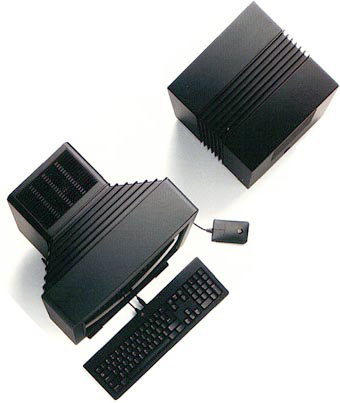
The NeXT Cube was a masterpiece of engineering… but too expensive. NeXT evolved into a software company after the Cube and several other NeXT hardware products failed in the marketplace. The company’s greatest innovation was the NeXTSTEP operating environment, including its rapid prototyping tools. CHM# 102626734
If Steve Jobs hadn’t gotten kicked out of Apple in 1985, the Web might look very different today. But not for the reasons most people might think.
Angry and deeply hurt, the arrogant, hard-to-control young entrepreneur sent a pointed message with the name of his next company: NeXT, Inc. The matte black cube computers he launched in 1988 cost a staggering $10,000. But besides their fast processors and enormous displays these cutting-edge machines ran the innovative NeXTStep operating system – today better known in its second incarnation as Mac OS X.
The original NextStep OS also included one of the easiest-to-use and most powerful application builders ever shipped. Some Wall Street investment firms spent millions on NeXTs to whip out applications that could mix up ever more exotic cocktails of the financial instruments known as derivatives, concocted from a byzantine brew of stocks, bonds, futures, and more. The NeXT application builder was like a turbocharged blender for making and tracking the resulting “swaptions,” and “captions,” and “collars.”
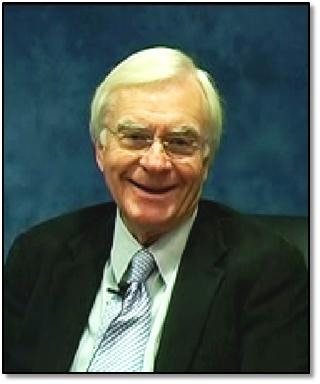
Richard Phillips
NeXTStep’s rapid prototyping features let Sir Tim Berners-Lee, the Web’s main inventor, write a prototype for the Web in two months in the fall of 1990. That prototype included the world’s first Web browser, which was also a full-featured editor for creating Web pages. The task would have taken over a year on other machines. The fast pace felt like a stroke of luck since the giant physics lab he worked for, CERN, gave the Web no official support.
Berners-Lee wasn’t the first geek in the world of high energy physics to fall in love with the NeXT. Paul Kunz at SLAC (Stanford Linear Accelerator Center) became a convert, and his enthusiast’s connection with Berners-Lee later played a role in bringing the Web to the United States.
Over at Los Alamos National Laboratory in New Mexico, birthplace of the atomic bomb, veteran programmer Dick Phillips was intrigued by the NeXT cube’s nearly unparalleled support for multiple media. Starting in 1988 he had built a rich browser-editor for multimedia collaboration over networks which he called, simply enough, MediaView.
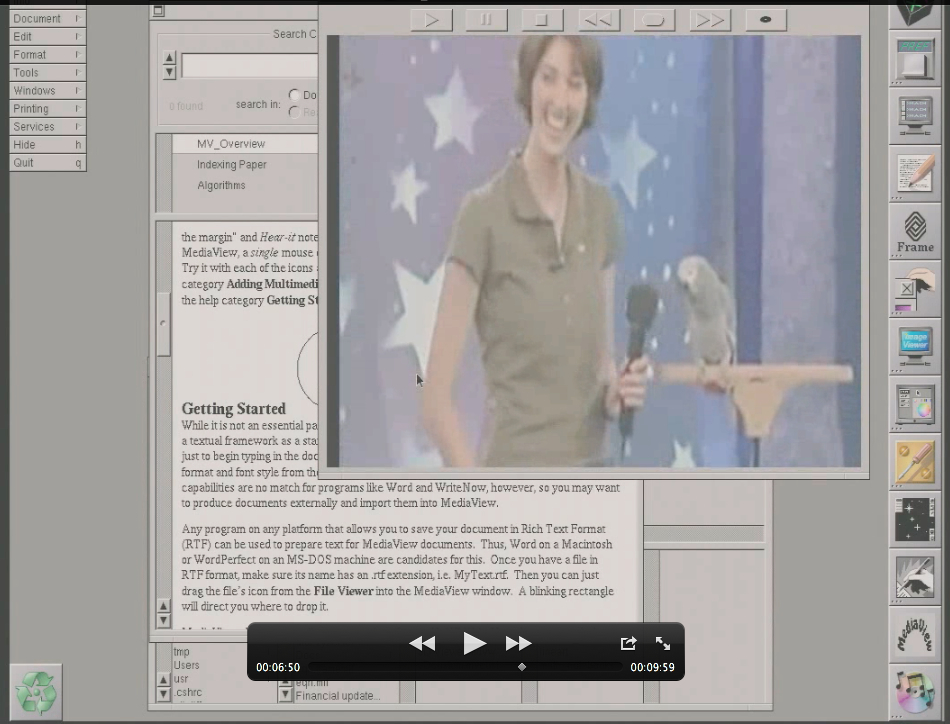
MediaView screenshot
His priority list was nearly the inverse of Berners-Lee’s Web browser-editor, which focused on demonstrating the raw mechanics of world-wide hypertext connections and left most formatting niceties and multimedia features for later.
Phillips had put multimedia first, including support for embedded audio, hand-drawn annotations, animation, and soon video and extensible custom components similar to the Java applets and browser plugins that would become common a few years later. He also offered support for high end graphics formats like Pixar’s RenderMan. On his “later” list was fleshing out MediaView’s hypermedia capabilities.
Video: MediaView overview video, 2012″
Phillips says that Berners-Lee recognized the possible synergies and asked him for a copy of the MediaView source code. A mashup of MediaView and his browser-editor could have accomplished all the multimedia dreams outlined in Berners-Lee’s own original web proposal in one go. Phillips was eager to oblige, but his employers at Los Alamos tangled the request in layers of IP restrictions and it never happened.
MediaView became one of the stars of the short-lived NeXT universe; written up in scholarly papers, featured in magazines, and demonstrated at top conferences including SIGGRAPH. [It seemed clear that people/professionals, at least, would soon author documents with a rich palette of media at their fingertips, and seamlessly share, annotate, and browse them over {high speed} networks]. Phillips himself served on the advisory council to develop NeXT’s high-end NeXTDimension graphics board, which brought stunning color and video to the second generation of the Cube. As Nextworld magazine wrote: “In some ways the NeXTDimension was designed to run MediaView rather than the other way around.[i]”
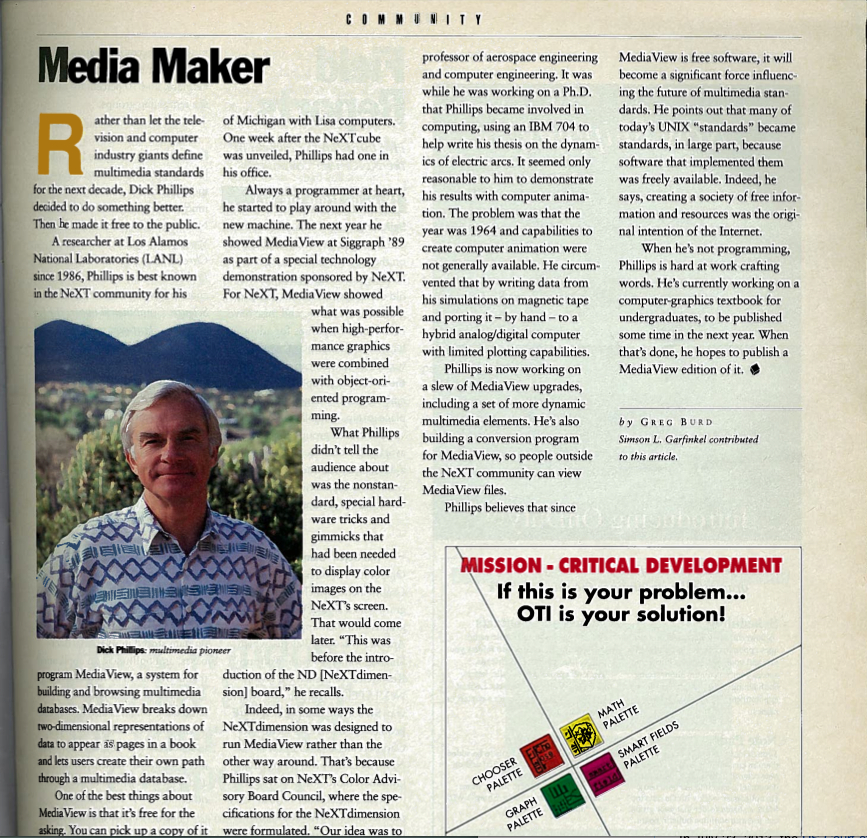
Article from NextWorld magazine
MediaView was one particular thread in that era’s general craze for multimedia, from bleeding edge tools for filmmakers to consumer CD-ROMs that seamlessly mixed high resolution images, video, and sound. Once-primitive personal computers had finally gotten powerful enough to handle multimedia in a useful way, and software publishers and game makers took full advantage. In the excitement, few guessed that the Web was about to kick off a long, slow crawl toward global networking that would push most people’s media experiences back into the stone age for another decade, one marked by screeching dial-up modems and image files painfully loading bit by bit.
As both Berners-Lee and Phillips would discover, the NeXT’s innovative preview of tomorrow’s computing powers proved double-edged. The overpriced machines never sold in substantial numbers, and rather than serving as a headstart, the very ease with which you could build applications on them became an obstacle. The ambitious feature set a programmer could crank out in weeks on the NeXT would require serious time and money to port to less powerful but more popular machines.
At CERN, Berners-Lee and his colleague Robert Cailliau submitted two proposals to port the Web browser-editor to the Mac, PC, and UNIX platforms, as well as developing some of the sorts of multimedia features already demo’d in MediaView. Both proposals were ignored.
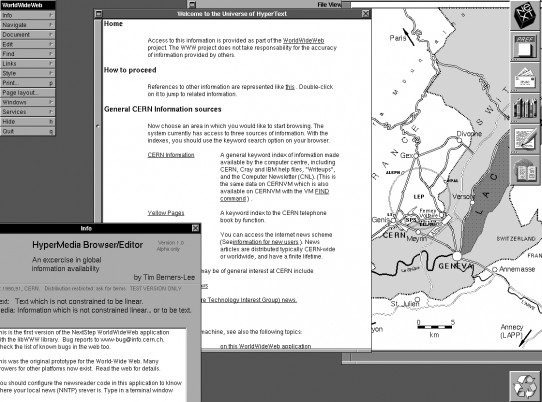
HyperMedia, the first Web browser, which was also an editor
Dick Phillips wanted to keep developing MediaView and further adapt it to common platforms, but his managers had other ideas. He was assigned to a telemedicine project, whose engine resembled parts of – you guessed it – MediaView.
In February of 2012, the fate of many aspects of our online world was decided by a non-technical, eight person jury in Tyler, Texas, an increasingly popular venue for patent suits. A tiny firm calling itself Eolas, or Irish for knowledge, claimed to have patented the whole concept of the “interactive Web” – basically anything within a Web page that moves or gets more dynamic than ordinary text – back in 1994.

Michael Doyle
This was the second time Eolas was suing the giants of the online world plus top bricks and mortar retailers for patent infringement, and demanding billions of dollars. In an earlier Microsoft suit, a Federal jury returned a verdict for more than $500 million in favor of Eolas against Microsoft, a record at the time. Microsoft later settled for over $100 million. The second round of litigation started by naming 23 companies, but most soon settled. The Tyler showdown was against the holdouts, including Amazon, Yahoo!, Google, YouTube, and JC Penney. If Eolas won, nearly every major company in the world could expect similar suits.
What made the Eolas case pivotal is that unlike some of the more creative claims by classic patent “trolls,” Mike Doyle and his two colleagues at University of California San Francisco (UCSF) really had thought of a useful application – a viewer for manipulating biological images over the Web in a customized version of the Mosaic browser – and done so quite early on. That Eolas had done little to further develop the ideas besides filing lawsuits was legally beside the point. The question was not whether Eolas was real, but whether it was first.
The jury began deliberating in the afternoon. Sir Tim Berners-Lee had testified, as had Dave Raggett, the architect of modern HTML. So had Eric Bina, co-creator of the Mosaic and Netscape browsers, and Pei Yuan Wei, author of the Viola hypertext system and later Web browser, Scott Silvey, developer of the v-plot application used with Viola, and Dick Phillips with MediaView. But for all sorts of legal reasons and restrictions held over from the first trial, the judge wouldn’t let the jury see videos of Viola in action.
One of the only working examples of early ‘90s software they did get to see live footage of was MediaView, which also predated the others by several years.
Timing was another factor. Aside from MediaView, with its paper trail from the early ‘90s, many of the other publicly recorded examples of prior art were goose-bump inducingly close in time. Although Viola had featured embedded applets nearly since its pre-Web 1989 start, the only solidly verifiable demos were in the summer and fall of 1993. Dave Raggett’s “embed” tag was debated on the main Web discussion board, www-talk, earlier that same year.
After only a few hours the jury’s decision came back. The verdict was that all of the major claims in Eolas’s two patents were invalid. The lead attorney for the defense, Jennifer Doan, said that all the prior art, but importantly the filmed MediaView demo, played a pivotal role in that decision.
We are in the process of collecting materials on MediaView, as well as on the Eolas case.
That short-lived dawn of the Web when its future was roughed out, some of it on NeXT machines, may not have survived in any continuous form. But in court, at least, the ghosts of those old inventions were summoned just long enough to help save the public Web from a potentially devastating blow. But they were just as quickly forgotten. Only the geek-facing magazine Wired bothered to cover the main trial in detail (links below). You had to hunt in the news to find notice of the summer 2013 defeat of a follow-up appeal from Eolas. The press is filled with stories of the important but far, far narrower battles between Apple and Samsung.
MediaView and Berners-Lee’s original NeXT browser-editor still have useful features not common today, from the latter’s seamless wiki-style authoring of everything online, to the primary goal of MediaView – seamless sharing and authoring of multimedia over networks. Just in preparing this blog, Dick Phillips and I wasted a couple of hours each dealing with incompatible video formats and clunky file transfers. These were the sorts of irritations MediaView hoped to put on history’s dustbin 25 years ago. Not all of the innovations of the NextStep rapid prototyping features are easy to find today, either. Perhaps one of you reading this will help carry these still undone visions forward, for a new generation.
[i] NextWorld-Phillips Article.pdf, Fall 1992 nextworld p.13